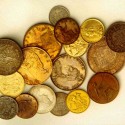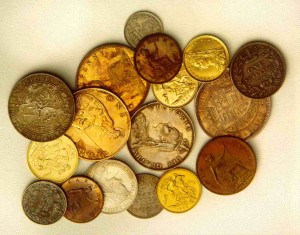A Scion Society of The Baker Street Irregulars

So, How much is a Quid, a Bob, and a Crown, Really?
“Give up a hundred thousand quid?”
– The Adventure of The Mazarin Stone (MAZA)

We, as modern American readers, have always had some problem in translating the British monetary system of the Victorian era into something more tangible, such as purchasing power. One who is not completely familiar with the monetary system of the time (certainly including us) has trouble in determining just how bad off Dr. Watson was with what he described in A Study in Scarlet as ” … an income of eleven shillings, sixpence a day … ” The context in which he mentions his income leads one to believe that he had found himself to be fairly impecunious – so much so that he was in need of a roommate (fortunately for us) with whom he might share the cost of lodgings. After puzzling the matter of the monies of the times off and on, we eventually asked one of our good British friends? viz., Brian May, to explain to us the intricacies of the Victorian monetary system. We shall try to convey to you, what Brian conveyed to us. Let’s start with the little money and work up – everything eventually comes out to be defined in terms of the penny (pence) ..
farthing – the smallest coinage = 1/4 penny
halfpenny (pronounced “hay-pinee”.) = 1/2 penny
penny – (in conjunction with other denominations is called “pence”.)
threepenny (thruh-pence) = three pennies
sixpence = six pennies
shilling 12 pence (1/20 pound sterling) in slang a “bob.”
two shillings = 24 pence (1/10 pound sterling)
two and six. — two shillings plus sixpence = 30 pence
five shillings – 60 pence (called a Crown)
one pound = 240 pence = 20 shillings (called a “sovereign”; a slang expression was “quid) = £
guinea = 1 pound plus one shilling
Interestingly enough, even though the guinea is repeatedly mentioned throughout the Canon, there was no coinage in that denomination during Mr. Holmes’ lifetime (the guinea had been discontinued in 1817). Nonetheless, it was still common for people to calculate their fees in guineas. This appears to have been something like our pricing an item at $49.95 rather than at $50.00; it just sounds like less. To the unpracticed ear, 20 guineas doesn’t sound like substantially more than 20 pounds, yet it is 20 shillings, or one pound, more! According to Brian, it was also considered more erudite (perhaps pretentious) to speak in terms of guineas rather than in terms of pounds!
A couple of other monetary things came to our attention after our communication with Brian. One was the mention made by Jonathan Small (SIGN) when fantasizing about ” … coming back with his pockets full of gold moidores … ” According to the late Jack Tracy, the moidore was originally a Portuguese coin in common usage in England during the first half of the 19th century; later the word persisted in the language to refer to a sum of twenty-seven shillings (1-7-0), the approximate worth ofthe gold coin. Then there.are the Napoleons which John Clay plotted to steal under the ruse of The Red Headed League. Jack Tracy told us that these were French gold coins with a value of about 9 1/2 shillings each (9/6, nine shillings and six pence or “nine and six,” two of these would be worth almost a pound).
So, if we look at Dr. Watson’s pension of 11 shillings six-pence per day in light of all this, we could convert his income to pence by multiplying 11 by 12 (12 pence in a shilling) and adding 6 pence, which equals 138 pence per day. Assuming that his income was really daily, then he had 138 pence times 365 days in the year or 50,370 pence per year. Dividing by 240 (the number of pence in a pound) we get almost £210 per year. Considering the facts that Violet Hunter (COPP) had been making only £4 per month (£48 per year) before she went to work for Rucastles and then she received roughly a 108 raise (to a most desirable £100 per year) from her new employers, the £210 which Dr. Watson was making doesn’t seem too bad. Compare, also, with Mary Sutherland’s (IDEN) income. She said that she had £2500 in New Zealand stock paying 4 112 percent (” … I can only touch the interest. .. “), this interest would come to £112.5 (112-10-0 or £112 ten shillings). Mr. Holmes further evaluated her situation by saying, “I believe that a single lady can get on very nicely upon an income of about £60.” This would have been less than one-third of Dr. Watson’s income, but, then, both Violet Hunter and Mary Sutherland had room and board provided.
As a sort of summary evaluation, consider that at the time the pound sterling was worth about $4.90 US.
This post was originally published in the Fall 1993 issue of The Sherlockian Times and was later reprinted in The Formidable Scrap-Book of Baker Street, edited by Carolyn & Joel Senter.

[…] response to our previous discourse concerning the intricacies of Victorian currency (“So, how much is a Quid, a Crown, and a Bob?; The Sherlockian Times: Fall 1993) we received a welcomed epistle from that most erudite Northern Musgraver Mr. John Hall (author of […]
“Farthing – the smallest coinage = 1/4 penny”.
This statement is not quite true!
At various times, from 1839 to 1868, there were minted Half- Farthings, Third-Farthings and even Quarter-Farthings! The Third-Farthing was minted only in 1844 and is now worth anywhere from 20 to 950 Pounds. It was made for use in Malta. The Quarter-Farthing (only 1/16 of a Penny!) was for use in Ceylon. But the Half-Farthing was legal tender in England.
Also: two shillings, sixpence (2/6) is called a Half Crown.
A bit of worth-while trivia: The term “Pound” actually means a pound! 240 pennies weighs, as well as equals monetarily, 1 pound.
I find this humorous – in the classic English sense – quite dry.
Coming full-circle, one might say; when young I knew many old folks (born ca 1875) whose sense of (American) humor still retained the dry wit of the English. Indeed, was the very core of American humor!
This informed me, yet again, of our (American) close familial connections with our English/British ancestors.
Addenda: The coin worth 2 shillings, sixpence (2/6) is called a Half Crown. Two shilling coin is known as a Florin (mentioned in CROO, when Henry Wood’s landlady thought that she had received “a bad Florin” as rent payment – which was actually an Indian Rupee).
Errata: the smallest coin value is NOT a Farthing. Also minted, between 1839 and 1868 was the Half-Farthing. In addition,there was a Third-Farthing, minted in 1844, and a Quarter-Farthing, minted in several years between 1839 and 1868. Some of these, in top condition, are now worth in excess of 1000 Pounds
Our friends at I Hear of Sherlock Everywhere linked to this page with Episode 121 of their Sherlock Holmes: Trifle podcast on Old Money. You can listen to that podcast at https://ihose.co/trifles121
After the Napoleonic wars Britain was on a gold standard until 1931. (The term ‘pound’ was originally denoting 1 pound in weight, though in the middle ages this was silver, whence ‘sterling’.)
In the 19th century gold standard, the pound was worth just under a quarter of a troy pound (about 7.3g) of gold, which in today’s prices is just over £300. A shilling is then around £15.
That puts, say, Bob Cratchit on about £1k per month, but Watson on quite a generous war wound pension.